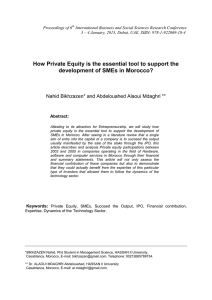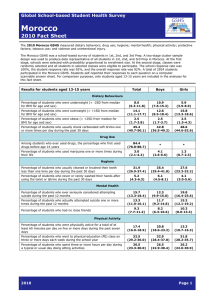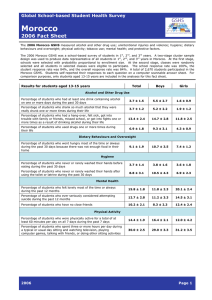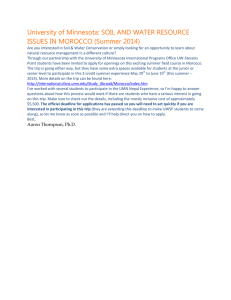Advances in Management & Applied Economics, vol. 5, no.1, 2015,... ISSN: 1792-7544 (print version), 1792-7552(online)
advertisement
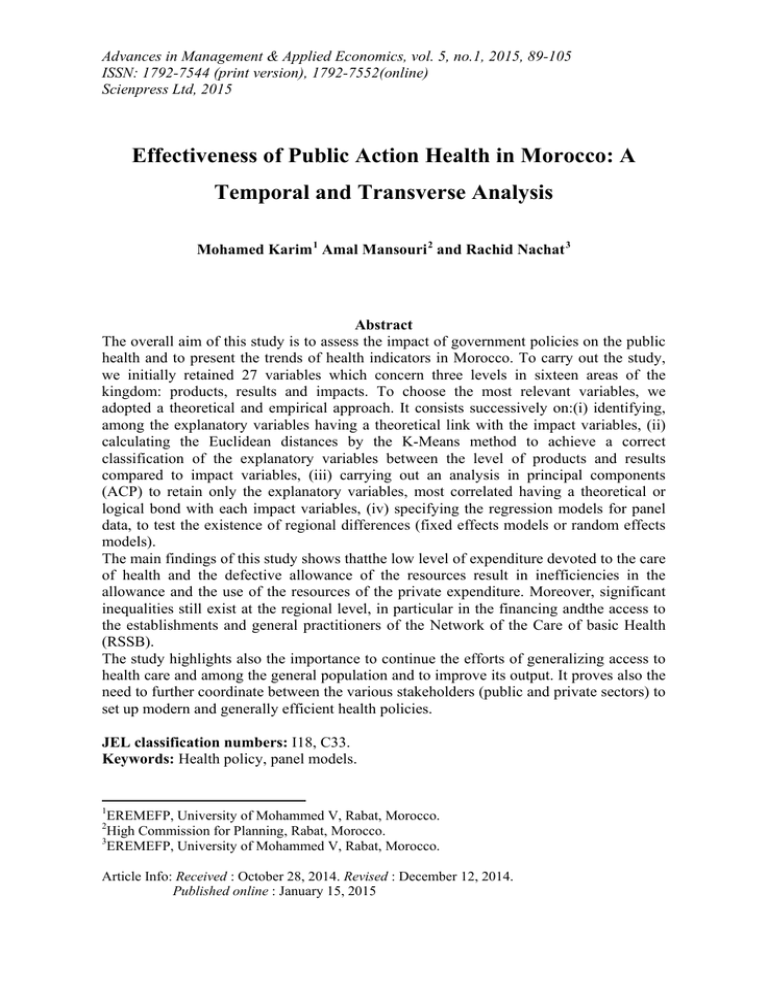
Advances in Management & Applied Economics, vol. 5, no.1, 2015, 89-105 ISSN: 1792-7544 (print version), 1792-7552(online) Scienpress Ltd, 2015 Effectiveness of Public Action Health in Morocco: A Temporal and Transverse Analysis Mohamed Karim 1 Amal Mansouri 2 and Rachid Nachat 3 Abstract The overall aim of this study is to assess the impact of government policies on the public health and to present the trends of health indicators in Morocco. To carry out the study, we initially retained 27 variables which concern three levels in sixteen areas of the kingdom: products, results and impacts. To choose the most relevant variables, we adopted a theoretical and empirical approach. It consists successively on:(i) identifying, among the explanatory variables having a theoretical link with the impact variables, (ii) calculating the Euclidean distances by the K-Means method to achieve a correct classification of the explanatory variables between the level of products and results compared to impact variables, (iii) carrying out an analysis in principal components (ACP) to retain only the explanatory variables, most correlated having a theoretical or logical bond with each impact variables, (iv) specifying the regression models for panel data, to test the existence of regional differences (fixed effects models or random effects models). The main findings of this study shows thatthe low level of expenditure devoted to the care of health and the defective allowance of the resources result in inefficiencies in the allowance and the use of the resources of the private expenditure. Moreover, significant inequalities still exist at the regional level, in particular in the financing andthe access to the establishments and general practitioners of the Network of the Care of basic Health (RSSB). The study highlights also the importance to continue the efforts of generalizing access to health care and among the general population and to improve its output. It proves also the need to further coordinate between the various stakeholders (public and private sectors) to set up modern and generally efficient health policies. JEL classification numbers: I18, C33. Keywords: Health policy, panel models. 1 EREMEFP, University of Mohammed V, Rabat, Morocco. High Commission for Planning, Rabat, Morocco. 3 EREMEFP, University of Mohammed V, Rabat, Morocco. 2 Article Info: Received : October 28, 2014. Revised : December 12, 2014. Published online : January 15, 2015 90 Mohamed Karim et al. 1 Introduction Health remains a major concern for the population and ranks on the list of their waiting. Moreover, it is recognized that good health is important for business andhelp to improve a productivity of the workforce. In Morocco, the government has ceaselessly made strenuous efforts since the independence to make progress inhealthcare services, spending around 5% of the gross domestic product on the health sector.This contributes tomark improvements in health status in most areas of the kingdom. Evidence was given by the human development indicators, which testify to a notable progression as regards of extension of health coverage and care services, a substantially reduced of infant, child and maternal mortality, with a clear increase of the life expectancy to the birth. It should also be underlined that public authorities launched many programs and plans of action in order to expand health insurance coverage and reduce disparities in access and financing between income groups and between areas. However, despite all the efforts made, Morocco remained a country with social inequalities and health inequity, with large disparities between regions, between rural areas and the urban cities. In light of this, the main purpose of this study is to identify the medical and educational public policies having exerted significant effects in all the areas and to measure their effects on the impact indicators.This will make it possible to draw from the lesson as for the suitable policies to limit the defective allowance of the public and private resources.With this intention, one must test if the public policies aiming at building hospitals, the availability of drugs and the operations of vaccination are successful and to see to what extent it could reduce of the diseases and the death incidence rate of the women to the childbirth. The remainder of the present report is organized as follows: the second point provides a brief review of literature. The medical context in Morocco is presented in the third point, which is followed in the fourth bya presentation of data and methodology.The fifth point gives insights on the results of the econometric treatments.The last will be reserved for the recommendations of relevant public policies. 2 Review of Literature Several empirical studies aiming at identifying the determinants of health focused on the estimate a production function of health.The majority of these studies referred to the indicators of infant mortality, of the premature mortality or life expectancy to the birth to better determine the explanatory factors of health. A pioneering study in this field was carried out by Auster, Levenson, and Sara check [1969].The main contribution of this study, conducted in the United States, focused on the insulation of environmental and economic factors of the traditional determinants of the medical care, retained before in the estimate of the production function of health.One second theoretical and empirical study, prepared by Grossman [1972], also revolutionized the analysis of the determinants of health.Indeed, Grossman considered the health of an individual compared to his opening inventory of health, with his time constraints and his income.Being given that health and education are dependent, he indicate that the education, measured by the number of years of studies, increases the effectiveness of Public Action Health in Morocco: A Temporal and Transverse Analysis 91 production of the good health and reduces the capital cost in the care of health to a given age. In the same line, Farrell and Fuchs [1982] examined the causal relation between the education and the health.In their study, they tested the assumption which stipulates that schooling influences the behavior of health.Considering the conclusions established by some economists relating to the positive effect of schooling on the production of a good health and those which support that some variables not observed as the reduction ratio of time (time discount misses).Shepherd, Mark C and Leigh, Paul J (1989) re-examined the causal relation education-health. Another study, based in particular on cross-section data, was carried out by Siddiqui and Mahmud (1991).The study laid the stress mainly on the effect differentiated from the socio-economic variables which affect the health according to the classification of the countries:developed or underdeveloped.The method of estimate of generalized least squares was used to evaluate the health according to several socio-economic variables, including gross domestic product per capita, the rate of elimination of illiteracy per capita, the expenditure of health, the urbanization, the female elimination of illiteracy, the number of doctors per capita, the number of male nurses per capita and the caloric intake per day. The study attested rather significant contribution of the rate of elimination of illiteracy, assigning at the same time the health in the countries to high incomes that that with weak income over all the period of observation. Schumacher, J Edward and Whitehead, John C (1996) studied the effect of some inputs on the production of health. Their analysis discussed the effect of integrating the measurements more improved of the health in order to be able to differentiate the relative importance from the determinants which can be regarded as local incentives and those which increase the productivity of the workers. Bichaka Fayissa (2008) presented an estimate of the production function of health, based on the Grossman model. Life expectancy to the birth was retained as dependent variable.The results obtained suggested that the increase in the food availabilities per capita, the rate of elimination of illiteracy and the reduction in the alcohol consumption had a significant favorable effect on the life expectancy. The expenditure of health had negative consequences on the health, which can be explained, according to the author, by the inefficiency of the health care. 3 Health Context in Morocco The Moroccan government has had for a few years set up a proactive policy to improve the medical situation of its population. The national strategy of health targeted, in particular, the reduction of the health inequalities, especially in the most underprivileged areas. Thus, within the framework of the global vision 2015 of this sector, the government implemented a strategy over the period 2008-2012, which aimed at ensuring the equity of the supply of care between the areas and the urban and rural environments, in order to facilitate the access for most stripped and to support the healthcare system by improving its reactivity and by reducing the cost of the care and the drugs. It also seeks to bring back the share supported by the households in the financing of the health to less than 25 % by 2015, and to completely take charges and manage their long standing chronic infections. This policy has led to a net improvement in the principal health indicators. Indeed, the death rates (of the children less than 5 years and infantile) clearly dropped thanks to the 92 Mohamed Karim et al. efforts provided in the fight against the transmissible diseases. The death rate of the children less than 5 years knew a notable fall between 1987 and 2011, while passing from 76‰ with 30.5‰. The same downward trend is noted for the infant mortality rate during the same period (from 57.4‰ to 28.8‰).This evolution results from the progress made in the fight against morbidity specific to this age bracket, especially through the vaccination programs (close to 94% of children made all obligatory vaccinations in 2009), the campaign to prevent and combat common diseases and the acute respiratory infections. However, in spite of the made efforts, the disparities between the areas remain high. The levels of infant mortality and the children less than five years mortality rate remain significant in the rural areas compared with the urban areas cities (figure 1).These disparities are explained by i) the socio-economic deficit that know the rural zones, ii) cultural considerations and iii) the insufficiencies of the of healthcare system in some areas. As an illustration, the areas of Tangier-Tetouan, Marrakech-Tensift or FesBoulman (table 1), still suffer from a lack of labor shortages in various occupations (notably doctors, nurses, and other specialized medical occupations) in both the public and private sectors. 40 Figure 1: mortality rate of children in Morocco by areas 30 20 10 0 Children less than five years mortality (per 1000) Urban area Infantile mortality (per 1000) Rural area Figure 1: Mortality rate of children in Morocco by areas Source: Ministry for health, Morocco Public Action Health in Morocco: A Temporal and Transverse Analysis 93 Table 1: Manpower of the doctors (public & private) by area 2011 45 Wadi-ED Dahab-Lagouira 146 Laayoune-Boujdour-Sakia El Hamra 190 Guelmim-Es-Sezmara 1156 Souss-massed-Drâa 696 Gharb-Chrarda-Beni Hssen 717 Chaouia-Ouardigha 1664 Marrakech-Tensift-Al Haouz 940 Area of the Eastern one 5097 Large Casablanca 3958 Reduction-salted-Zemmour-Zaer 699 Doukkala-Abda 407 Tadla-Azilal 958 Meknès-Tafilalet 1326 Fès- Boulemane 461 Taza-Al Houceima-Taounate 1293 Tangier-Tétouan Total 19753 Source:Ministry for health, Morocco In spite of the efforts made in this field, the level of infant mortality in Morocco remains high compared than most of MENA countries and the other comparator countries. Currently, the infant mortality rate (less than 5 years) in Morocco is of 30.5‰, significantly stronger than the countries comparators (only Indonesia posts a comparable rate) (figure 2). Figure 2: Children less than five years mortality (per 1000), Morocco and comparator countries,-2012 35 30 25 20 31 15 30,5 10 5 9,1 8,5 12,2 16,1 14,2 Tunisia Turkey 0 Chile Indonesia Morocco Malaysia Romania Figure 2: Children less than five years mortality (per 1000), Morocco and comparator countries, -2012 Source: Ministry for health, Morocco & Indicators of Development, the World Bank 94 Mohamed Karim et al. Similar discrepancies can also be observed on the level of the other indicators of health such as maternal mortality. Indeed, in spite of a remarkable fall during the twenty last years, the death rate in the rural zones remains high (the ratio of maternal mortality in rural area is twice more significant than in urban environment:148 against 73 deaths for 100000 alive births in 2011).This is due to the deficiencies in antenatal care and the small proportion of the childbirth in supervised area. This is compounded by the inadequate storage capacity of hospitals which did not increase at the same rate as population. For example, in 2011, this rate was about 92.1% in the urban environment but didn’t exceed a threshold of 50% in rural medium. It should be noted that in spite of the remarkable decrease (past of 332 per 100 000 births in 1998 to 112 in 2011), this indicator remains still high compared with the countries having the same level of development. Morocco has to intensify its efforts to achieve the goal of the millennium in 2015, that is to say 83 deaths by 100 000 alive births. Figure 3: maternal mortality ratio (per 100,000 live births), Morocco and comparator countries, 2011-2012 250 200 150 220 100 112 50 0 25 Chile Indonesia Morocco 29 27 Malaysia Romania 56 Tunisia 20 Turkey Figure 3: Maternal mortality ratio (per 100,000 live births), Morocco and comparator countries, 2011-2012 Source: Ministry for health, Morocco & Indicators of Development, the World Bank Side of the financing of the efforts are deployed to improve the health services and to increase the access to these services in the underprivileged areas. In this direction, the expenditure health increased since 2005 passing from 5,1% of the GDP with 6,3% in 2013.The strategy of health installation aims at a greater investment in the underprivileged areas. However, the budget allocated for health accounts for only 5% of the general budget of the State,far below the WHO (the World Health Organization) international standard of 10%. Morocco thus posts still a low level of public expenditure per capita (Figure 4). Public Action Health in Morocco: A Temporal and Transverse Analysis 95 Figure 4: Public health expenditure in relation to GDP per capita Source: Ministry for health, Morocco & Indicators of Development, the World Bank We can reasonably conclude from the examination of the various indicators by area that significant inequalities quality access to the various health services. The acceleration of the reforms in progress would be necessary to make up for lost time as regards access to the various medical services. 4 Data and Methodology In order to assess the impact of public policies on the health indicators, we retained a main sample composed of three types of variables: products, results and impacts. We used a dynamic panel data on 16 areas of Morocco over 2000-2012. The data collected from the report of the Ministry for Health. Appendices 1 present the theoretical specifications with an indication of expected signs.27 variables were treated. The choice of the specifications is tallied by the contents of the logical and theoretical framework of evaluation, commonly allowed, and which takes account of the determinants of the function production of health. The selection process of variables will be based on: An identification of the explanatory variables, which have a theoretical bond with the variables of impacts; An implementation of the principles components analysis in order to retain only the explanatory variables, most statistically correlated, among those having a theoretical or logical bond with each variable of impact.The calculation ofcorrelation is moreover led for some potentially relevant variables of products in connection with some variables of results for the two sectors; A specification ofpanel regression models, which makes it possible to identify the explanatory variables which are at the base and to test the significance of regional differences (effects fixed or random). A re-specification of panel models so to retain the parsimonious model and most explanatory, according to a recursive method for each impact as regards of the examination of the parameters and their signs' as well as the analyzing of the statistics like Student, R2 (Within)… 96 Mohamed Karim et al. The retained econometric specifications make it possible to highlight the relations between the explained variables and the explanatory variables.The specification which is applied takes the following functional form:Y = F(W), With Y:vector of the impacts variables for health and W:vector of the explanatory variables. Using the panel models, we examine the bond between the determinants of impact of health for the 16 areas.This examination makes it possible to collect the regional differences in the evolution of impact indicators of health.It concern in particular the following variables: Incidence rate of measles; Incidence rate of tuberculosis; Incidence rate of the viral hepatitis; 5 Presentation of the Results It is a question of combining a simple descriptive analysis based on the calculation of the average rates of the health indicators between two periods:2000-2004 and 2005-2012, with the results of econometric processing in panel data, in particular when the regional differences exist.It proves that the inclusion of "the areas effect" makes it possible to clarify the behavior of health between each area. 5.1 Incidence Rate of Measles The average rate of incidence of measles, between the two appointed periods 2000-2004 and 2005-2012, recorded an improvement passing at the national level, of 220,4 per 100.000 inhabitants with 53,3 per 100.000 inhabitants.It also gets clear that at the regional level, this improvement is observed in the areas of WadiEddahab-Lagouira, LaayouneBoujdour-Sakiahamra, GuelmimSmara, Souss-Massed-Draa, El Gharb-ChrardaBniHssaine, Marrakech-Tensift-El Haouz, the Eastern one and Taza-Al HoceimaTaounate. The question is then one of which werethe main factors underlying this trend.It is obvious that these determinants can affect each area differently and their weights can change in time. One must test if the basic and material infrastructures and the vaccination campaigns implemented could reduce, at the regional level, the incidence rate of measles. Theoretically, one expects, for example, so that the higher the number of establishments of basic health care increases, the lower the incidence rate of measles.In the same way, more one vaccinates less there is case of measles. It arises from the examination of the signs of the explanatory variables, contained in the table in appendix 3.2, that the suggested variables, however relatively relevant, is the number of the establishments of basic healthcare for 1000 inhabitants. Moreover, its sign compared to the incidence rate of measles is in conformity with what is expected in theory.By contrast, the two other variables (number of pharmacists and vaccines in VAR of the children from 12 to 23 months for 1000 inhabitants), are not relevant.Indeed, an increase by 1 point in the number of the establishments results in a fall of 0.170 point in the incidence rate of the measles. Public Action Health in Morocco: A Temporal and Transverse Analysis 97 On the other hand, considering the signs of the coefficients, the impact of vaccination on the incidence rate of measles is positive.This resultstatistically is not significant and at odds with what it is expected, can be explained by the inefficiency of the vaccination campaigns (chain of cold) and the limitation of sensitizing, the appearance of the cases of post-vaccine measles, the importation of new cases which propagate the disease and the increase in the momentary cases. 5.2 Incidence Rate of Tuberculosis The average rate of incidence of tuberculosis, between the two appointed periods 20002004 and 2005-2012, has increased significantly, rising from 96,5 per 100.000 inhabitants to 83,8 per 100.000 inhabitants. The areas of Wadi Eddahab-Lagouira, LaayouneBoujdour-Sakiahamra and Guelmim-Smara showed good results while the13 other areas recorded all of the moderate results. Thus, one proposes to test if the basic infrastructures and the effort of vaccination provided contribute to a decrease of incidence rates of tuberculosis.Theoretically, one expects, for example, so that if the number of establishments of healthcare and the number of the children vaccinated in BCG increases, the incidence rate of tuberculosis drops. It arises that suggested variables, however most relevant, are in the order: the number of medical consultations and the number of doctors in the public sector.Moreover, their signs compared to the incidence rate of tuberculosis are in conformity with what is expected in theory.Indeed, a raise of medical consultation results in a fall of the incidence rate of 0.001 point. In addition, it would have to be noted that an increase of the number of doctor allows gaining 0.028 point of the incidence rate of tuberculosis.As for the variable, vaccines in BCG are not relevant. In connection with the constant, it is necessary to be careful in its interpretation because of the presence of the constants relating to the binary variables which the effect of each area.The regional differences are also lighting. It must be noted, for example, that the coefficient of area 2 (Laayoune-Bojdour-SakiaHamra), estimated of 10,12 is definitely lower than that of the area 13 (Meknes-Tafilalet) which is of 351,08.This wants to say that the incidence rate of tuberculosis in area 2 is lower than that of area 13, by taking account of the effect of the number of doctors in the public sector, a number of medical consultations and vaccine in BCG for children from 12 to 23 months.The areas of the South of Morocco are thus less vulnerable than the area of Marrakech-Tensift-El Haouz. 5.3 Incidence Rate of the Viral Hepatitis The average rate of incidence of the viral hepatitis recorded an improvement between the two appointed periods: 2004 and 2005-2012, risingfrom 8,2 per 100.000 inhabitants to 1,8 per 100.000 inhabitants.The following areas saw good results, especially WadiEddahabLagouira, Laayoune-Boujdour-Sakiahamra, Chouia-Ourdigha, Guelmim-Smara, Doukkala-Abda, Taza-Al Hoceima-Taounate and the eastern area. Thus, one must test if the public policies aiming at the construction of hospitals and the reinforcement of the auxiliary nursing staff, the availability of the drugs and the operations of vaccination are successful policies and in which measurements could reduce the incidence rate of the viral hepatitis in the Moroccan areas. 98 Mohamed Karim et al. Theoretically, one expects, for example, so that more the number of establishments of basic healthcare increases more the incidence rate of the viral hepatitis drops.In the same way, more one vaccinates the children with the BCG less there is case of viral hepatitis. It arises that suggested variables, however most relevant, are in the order as follows:the number of pharmacists in the private sector and the number of doctors in the public sector.Moreover, their signs compared to the incidence rate are in conformity with what is awaited in theory.One notes a light significance of vaccines in BCG of malnourished children aged less than11 months.Indeed, an increase of 1 point of the pharmacist’sratio for 1000 inhabitants in the private sector leadsto a fall of 61.627 points of the incidence rate. In addition, it should be noted that a higher of the public doctor ratio for 1000 inhabitants by 1 point, makes lower by 22.461 points the incidence rate of the viral hepatitis. Moreover, the parameters of the constant of area 2 and 3 are weak, because of a characteristic in term of behavior of the diseases. By contrast, the cases of the diseases remains high in area 7 (Marrakech-Tensift) and in area 9 (large Casablanca). 6 Relevant Public Policies In the field of health, the low level of expenditure devoted to the healthcare and the defective allowance of the resources result in inefficiencies in the allowance and the use of the resources of the private expenditure.Thus, the share of the public expenditure devoted to health is 34,3% is the lowest rate of the area carried out and that from private the 65,7% of the total. Moreover, the examination of the various indicators of health by area reveals significant inequalities as regards the financing or access to the establishments and general practitioners of the Network of the basic Healthcar (RSSB) like with the wards. The six areas underprivileged for this reason are: Souss-Massed-Draa, El Gharb-ChrardaBeniHssen, Doukkala-Abda, Tadla-Azilal, Taza- Al Hoceima-Taounate, Tangier-Tetouan, Oued ED Dahab-Laguira and Chaouia-Ouardigha. In front of the weakness of the allocated budgets and their rate of execution which do not exceed 35% the year our evaluation went up that the public policies access on the reinforcement of the number of doctors, the follow-up of the care and the availability of the drugs in the Moroccan areas exert more effect positive on the incidence rates of measles and tuberculosis much more than the effect of construction of the hospitals and the vaccines which prove in the state less effective. As for the deaths of the women to the childbirth, the monitoring and the follow-up count more than the number of wise women. In conclusion, this analysis highlights the importance to continue the efforts of generalization of the access to the system of medical and to improve its output. It proves also necessary to coordinate between the various parts (public sector and public) to set up the policies and the strategies of adequate health. Public Action Health in Morocco: A Temporal and Transverse Analysis 99 References [1] [2] [3] [4] [5] [6] [7] [8] [9] [10] [11] [12] [13] [14] J.C. Berthélémy, Relations between health, development and reduction of poverty, Academy of Science Morals and Policies, University Paris 1 the Pantheon Sorbonne, (2007). H. Lofgren and C. Diaz-Bonilla, MAMS:Year Economy wide Model for Analysis of MDG Country Strategies, Technical documentation, World Bank, (2006). M. Karim, Viability of the Moroccan finance public, Edition L Harmattan, France chapter 8, Financing of the sector of education, (2010). M. Karim, Evaluation of the budgetary support in Morocco, Study carried out by ADE, Decision-Making Aid Economic, European Union, (2013). Ministry for Health, To reconcile the citizen with his system of health, Action plan Health 2008-2012, (2008). Ministry for Health, A news governance of the sector of health, 2nd national conference on health, delivers white Marrakech, the 1, July 2-3, (2013). Ministry for Health, Investigation into the population and family Health (EPSF), 2003-2004, Macro ORC and Arab Program for the promotion of childhood, Mars, (2005). Ministry for Health, National survey into the Health of the mother and child (ENSME), 1997, Arab Program for the promotion of childhood, July, (2009). Ministry for Health, Sectorial strategy of health : 2012-2016, Mars, (2012). Ministry for Health, Health in figures, (2010). P. Aghion, P. Howitt and F. Murtin, The Benefit of health:A contribution of the endogenous theories of growth, Re-examined OFCE, Volume 112, (2010), 87-108. Report of the fiftieth anniversary, Possible Morocco :An offer of debate for a collective ambition ", Fifty years of human development, prospects 2025, (2006). World Health Organization, Report on health in the world 2006, (2006). World Health Organization, Strategy of co-operation WHO, Morocco 2008-2013, (2009). 100 Mohamed Karim et al. Appendix Table A1: Theoretical specifications of health at the regional level Incidence rate of measles A number of establishments of care of basic health Ratio habitant/establishment of care of basic health Bed capacity Numbers doctors of the public sector (all confused specialties) Ratio living by doctor public sector (all confused specialties) A number of private doctors Pharmacists of the private sector Womenexaminedinto postnatal VAR of the 12-23 month old children VAR Children 24-59 monthold 0-11 montholdchildren malnutris Incidence rate of tuberculoses A number of establishments of SSB Ratio habitant/établissement of SSB Numbers doctors public sector (all confused specialties) Ratio living by doctor public sector (all confused specialties) A number of private doctors Pharmacists of the private sector A number of ancillary medical consultations A number of medical consultations BCG of the 12-23 month old children 12 -23 month old children who have Poids/Age higher than the normal 24 -59 Malnutris montholdchildren Incidence rate of the viral hepatitis A number of establishments of SSB Numbers doctors of the public sector (all confused specialities) Ratio living by doctor of the public sector (all confused specialities) Numberof privatedoctors Pharmacists of the public sector Pharmacists of the private sector Number of admissions A number of medical consultations Born-alive 0 -11 montholdchildren, malnutris 12 -23 month old children who have a poids/Age higher than the normal Rate of death of the women to the childbirth A number of establishments of SSB Capacitylitter A number of doctors of the public sector exerting in RH A number of doctors specialists in the RSSB A number of midwives Averageoccupancy rate New inscription with the PSGA Pregnancyat the risk Total of been confined in a supervised medium Complicated cases of childbirth Expected sign + + + ? + + + + Public Action Health in Morocco: A Temporal and Transverse Analysis 101 Table A2: Incidence rate of measles by area (a Number of cases for 100.000 inhabitants) Régions/Périodes 2000200520002004 2012 2012 01- Wadi-Eddaab-Lagouira 256,96 72,67 149,46 02- Laayoune-Bojdour-Sakia Hamra 485,28 52,80 233,00 03- Guelmim Smara 260,76 95,00 164,06 04- Under-Massed-Draa 201,88 43,45 109,46 05- El Gharb-Chrarda-BniHssaine 137,44 25,01 71,86 06- Chouia-Ourdigha 59,56 18,17 35,42 07- Marrakech-Tensift-El Haouz 229,04 12,90 102,96 08- Eastern Area 337,92 31,84 159,38 09- Large Casablanca 212,38 46,63 115,69 10 Reduction-Salted-Zemmour-Zaer 149,76 38,98 85,14 11 Doukkala-Abda 65,96 16,10 36,87 12 Tadla-Azilal 126,88 14,41 61,28 13 Meknes-Tafilalet 209,44 56,71 120,35 14 Fes-Boulemane 212,64 124,02 160,94 15 Taza-Al Hoceima-Taounate 486,08 34,05 222,40 16 Tangier-Tetouan 316,30 118,85 201,12 National total 220,40 53,28 117,56 Source:Arithmetic calculations of mean on the basis of data of the Ministry for health 102 Mohamed Karim et al. Table A3: Specification of the incidence rate of measles Estimator A number of establishments of care of basic health for 1000 inhabitants Expectedsign - A number of pharmacists of the sector deprived for 1000 inhabitants - VAR of the 12-23 month old children for 1000 inhabitants - Fixedeffects 02- Laayoune-Bojdour-Sakia Hamra 03- Guelmim Smara 04- Under-Massed-Draa 05- El Gharb-Chrarda-BniHssaine 06- Chouia-Ourdigha 07- Marrakech-Tensift-El Haouz 08- Eastern Area 09- Large Casablanca 10 Reduction-Salted-Zemmour-Zaer 11 Doukkala-Abda 12 Tadla-Azilal 13 Meknes-Tafilalet 14 Fes-Boulemane 15 Taza-Al Hoceima-Taounate 16 Tangier-Tetouan Constant R-squared (Between) R-squared (Within) Rho (Fraction of the variance due has u_i) P-been worth test of Haussmann Fisher Nombre observations (areas) 137.430 -271.836 -276.502 -153.238 -23.050 -253.303 139.977 196.434 261.202 -180.287 -255.997 -89.186 -20.647 -233.29 -91.983 747.186 0.035 0.206 0.592 0.002 4.21 208 MCG 0.170 (1.112) -2.535 (0.415) 0.569 (0.417) * Significativitywith 5% Table A4: Incidence rate of tuberculosis by area (a Number of cases for 100.000 inhabitants) Régions/Périodes 01- Wadi-Eddaab-Lagouira 02- Laayoune-Bojdour-Sakia Hamra 03- Guelmim Smara 04- Under-Massed-Draa 05- El Gharb-Chrarda-BniHssaine 06- Chouia-Ourdigha 07- Marrakech-Tensift-El Haouz 08- Eastern Area 09- Large Casablanca 10 Reduction-Salted-Zemmour-Zaer 11 Doukkala-Abda 12 Tadla-Azilal 13 Meknes-Tafilalet 14 Fes-Boulemane 15 Taza-Al Hoceima-Taounate 16 Tangier-Tetouan National Total 2000-2004 102,02 93,24 52,24 58,84 111,06 87,78 72,86 73,04 146,78 140,76 90,78 63,08 77,22 133,54 67,74 122,12 96,54 2005-2012 32,58 58,05 50,43 55,60 95,08 76,68 54,60 63,18 275,74 112,01 79,40 54,70 60,44 110,82 63,35 120,18 83,58 2000-2012 61,51 72,71 51,19 56,95 101,74 81,31 62,21 67,29 222,01 123,99 84,14 58,19 67,43 120,29 65,18 120,99 88,98 Source: Arithmetic calculations of mean on the basis of data of the Ministry for health Public Action Health in Morocco: A Temporal and Transverse Analysis 103 Table A5: Specification of the incidence rate of tuberculosis Estimator A number of medical consultations for 1000 inhabitants Expectedsign - BCG of the 12-23 month old children for 1000 inhabitants - Fixedeffects 02- Laayoune-Bojdour-Sakia Hamra 03- Guelmim Smara 04- Under-Massed-Draa 05- El Gharb-Chrarda-BniHssaine 06- Chouia-Ourdigha 07- Marrakech-Tensift-El Haouz 08- Eastern Area 09- Large Casablanca 10 Reduction-Salted-Zemmour-Zaer 11 Doukkala-Abda 12 Tadla-Azilal 13 Meknes-Tafilalet 14 Fes-Boulemane 15 Taza-Al Hoceima-Taounate 16 Tangier-Tetouan Constant R-squared (Between) R-squared (Within) Rho (Fraction of the variance due has u_i) P-been worth test of Haussmann Fisher Nombre observations (areas) 29.394 26.355 4.466 54.888 42.687 41.700 46.718 174.193 163.177 23.392 37.621 65.452 125.971 29.529 60.028 153.767 0.072 0.072 0.351 0.000 7.37 208 MCG -0.234 (0.061) -0.059 (0.090) * Significativity with 5% Table A6: Incidence rate of the viral hepatitis by area (a Number of cases for 100.000 inhabitants) Régions/Périodes 01- Wadi-Eddaab-Lagouira 02- Laayoune-Bojdour-Sakia Hamra 03- Guelmim Smara 04- Under-Massed-Draa 05- El Gharb-Chrarda-BniHssaine 06- Chouia-Ourdigha 07- Marrakech-Tensift-El Haouz 08- Eastern Area 09- Large Casablanca 10 Reduction-Salted-Zemmour-Zaer 11 Doukkala-Abda 12 Tadla-Azilal 13 Meknes-Tafilalet 14 Fes-Boulemane 15 Taza-Al Hoceima-Taounate 16 Tangier-Tetouan National Total 2000-2004 10,18 2,68 1,32 4,26 5,82 2,76 14,34 5,20 13,26 16,06 3,90 5,58 14,70 6,48 4,40 8,50 8,18 2005-2012 0,57 0,26 0,23 1,28 1,38 0,36 1,15 0,82 4,09 2,17 0,99 2,26 3,47 2,96 0,75 1,51 1,82 2000-2012 4,57 1,27 0,69 2,52 3,23 1,36 6,65 2,64 7,91 7,96 2,20 3,46 8,15 4,43 2,27 4,42 4,13 Source: Arithmetic calculations of mean on the basis of data of the Ministry for health 104 Mohamed Karim et al. Table A7:Specification of the incidence rate of the viral hepatitis Estimator Numbers doctors in the public sector (all confused specialities) for 1000 inhabitants Pharmacists of the sector deprived for 1000 inhabitants Expectedsign - BCG of the 0 -11 month old children malnutris for 1000 inhabitants - Fixedeffects 02- Laayoune-Bojdour-Sakia Hamra 03- Guelmim Smara 04- Under-Massed-Draa 05- El Gharb-Chrarda-BniHssaine 06- Chouia-Ourdigha 07- Marrakech-Tensift-El Haouz 08- Eastern Area 09- Large Casablanca 10 Reduction-Salted-Zemmour-Zaer 11 Doukkala-Abda 12 Tadla-Azilal 13 Meknes-Tafilalet 14 Fes-Boulemane 15 Taza-Al Hoceima-Taounate 16 Tangier-Tetouan Constant R-squared (Between) R-squared (Within) Rho (Fraction of the variance due has u_i) P-been worth test of Haussmann Fisher Nombre observations (areas) -1.267 -11.903 -12.336 -7.524 -4.306 -6.504 -1.468 10.923 21.036 -8.549 -9.909 -0.722 -0.310 -14.381 -6.856 27.502 0.236 0.449 0.846 0.000 51.33 208 * Significativity with 5% - MCG -22.461 (4.015) -61.627 (14.967) 2.979 (2.845)


